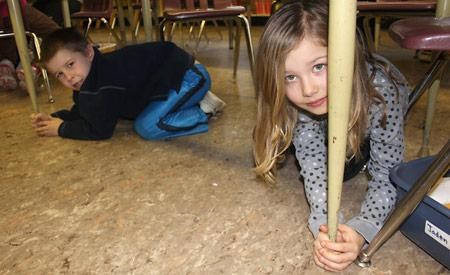Come next Wednesday, January 26 students, families, businesses, government agencies, individuals and anybody else who wants to participate will be dropping, covering and holding on for the Great British Columbia ShakeOut.
Inspired by the Great California Shakeout event, this will be the first province-wide earthquake drill held in BC. With over 300,000 people registered to participate so far, the drill will be the largest in Canadian history. As of Monday, January 17, 1,572 residents in Powell River are registered to participate, including individuals and people registered through schools, government agencies, health care facilities and non-profit organizations.
At 10 am those registered for the event will take a moment to pretend an earthquake is happening, drop to the floor underneath a sturdy desk or table and hold on until the drill is over. If no desk is available organizers recommend people cover their face and head with their arms, and crouch in the corner of a room. After the initial “shake,” groups taking part are then encouraged to go over escape routes and muster points and discuss the response of participants.
“Earthquakes are unique in that there’s really no warning and there’s no way to prevent them,” said Ryan Thoms, emergency coordinator for Powell River Regional District. “We know they happen and the longer it’s been since an earthquake happened, in our human nature, it seems like it’s less of a threat, when the reality is...actually quite the opposite.”
For residents of the West Coast and Vancouver Island especially, the need for preparedness in case of an earthquake is more than just make believe. Below the ocean floor off the west coast of Vancouver Island the Juan de Fuca plate is sliding beneath the North American plate, creating a subduction zone that causes small earthquakes almost daily.
It also causes large earthquakes. Of the top 10 largest recorded earthquakes in Canadian history, six of them occurred off the coast of British Columbia. The largest earthquake to ever hit Canada occurred off the coast of Vancouver Island on January 26, 1700, a date that is being recognized by the ShakeOut drill. This “megathrust” quake is believed to have had a magnitude of around 9.0 and was felt from BC to Northern California, according to information from Natural Resources Canada. The quake caused landslides, wiped out first nations villages and triggered a tsunami that caused destruction in Japan.
Dr. John Cassidy, an earthquake seismologist with Natural Resources Canada based in Saanich, said that data from past earthquakes indicates large megathrust quakes can be expected to occur in this region once every 250 to 800 years. It has been over 300 years since the last major earthquake which leaves us in the timeframe where a large earthquake could potentially occur.
Aside from the mega-thrust earthquakes, smaller but still potentially destructive earthquakes occur in this area, sometimes only decades apart. Earthquakes ranging from magnitude 6.9 to 7.3 occurred off the coast of Vancouver Island in 1918 and 1946 and Cassidy said that similar events could occur at anytime. They are deeper earthquakes that happen 50 to 60 kilometres below the surface. “Where that band of deep earthquakes occurs is right beneath the Strait of Georgia,” said Cassidy.
“The potential is there. The same plate movements are happening today as happened 100 years ago and 1,000 years ago. The same forces are at work,” he said. “The energy is being stored for more earthquakes in the future. We know that they’ll happen, we just don’t know when.”
The lack of predictability makes preparedness all the more important. At an Emergency Coordinators meeting on Thursday, January 13, Thoms spoke about ShakeOut and urged everyone to register and get involved. Doug Nauer, emergency services coordinator for the Provincial Emergency Program, said that the City of Powell River has an official earthquake response plan that lays out who is responsible for coordinating what response services and just what needs to be considered and dealt with when a quake occurs.
ShakeOut is also helping people prepare their homes and work places before the ground starts shaking. The program’s website, http://ShakeOutBC.ca, has a Flash game designed to teach players what sort of steps need to be taken to prepare. The game provides the viewer with a room filled with objects and decisions must be made about what measures need to be taken with each of these objects, such as bolting the bookcase to the wall or reinforcing the ceiling fan, before the earthquake hits.
Thoms would like to see people go through their own homes or workspaces and look, just as in the game, at what will be potential hazards during an earthquake. Putting together an emergency kit for surviving without water, electricity, natural gas, telephone service and all other services is also recommended. Learning how to turn off gas and water at home or office is also a good idea.
The goal is to make the Great BC ShakeOut an annual event to keep preparedness fresh and current. There is hope to eventually have a Cascadia subduction zone-wide earthquake drill that brings together BC, Washington, Oregon and California for one massive drill. This year Oregon is having its first ever drill on the same day as BC, while California’s took place on October 21 with 7.9 million participants.
To participate readers can visit ShakeOut BC's website to register together with family, colleagues or as an individual.



